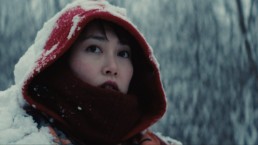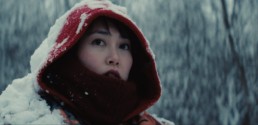Review: ‘Kumiko, The Treasure Hunter’
A Japanese aesthetic and dip into fantasy drives this 'Fargo' inspired film.
Human beings sometimes take for granted the gift of communication. In a world so enveloped in its own social media and online dating, the idea of isolation becomes both terrifying and obscure. It is sometimes difficult to define this type of loneliness as it transcends the physical and the technological barriers of existence.
In the Zellner Brothers’ Kumiko, the Treasure Hunter, this isolation is displayed on the screen in all its darkly humorous glory, as Kumiko (Rinko Kikuchi) faces two obstacles that trap her within the bonds of seclusion: a language barrier in the United States, and social awkwardness amongst her peers and family in Japan. All of this she finds on her journey from Tokyo to the American mid-west, to seek out a treasure that she has discovered by deciphering clues within a strange and mysterious film (a copy of the Coen Brother’s 1996 classic, Fargo).
The film is shot in two very different regions, as half the film takes place in the very urban and tradition-bound Tokyo, and the other in various snowy Minnesota locales. Director David Zellner explains that shooting in these two settings was crucial in that “the different landscapes and environments and cultures are almost like secondary characters in the film.” This allows for an even greater feeling of empathy and appreciation for Kumiko’s isolation, in that even the world around her rejects her.
Her futile and feeble struggles to maintain some small form of conformity within her world, such as half-hearted attempts at social interactions at work and with her family, are heartbreaking because they remind us of the times we have found ourselves without any control of our lives. We recognize the familiar feeling that we must do what is expected of us, not what is always expected by us.
The filmmakers challenge audiences to release their expectations of what real life is, and if audiences successfully reach this state of hope upon conclusion, then the ending greets them like a cheering crowd at a finish line.
The Zellner’s continue to use themes of isolation within their very specific choices of color. The choice is made very early on that, Kumiko, being the fantastic factor of the narrative, has a color score of a hot-rod red hooded jacket to reflect that. This bright red “eye magnet” stands strong against the brown and gold color pallet of Tokyo, and the 50-plus shades of white that seems to constantly envelope the American mid-west. This choice of bold color symbolism as a motif that doesn’t play games with the viewer’s head and makes a clear distinction as to its intention, which has all but disappeared from more recent films. However, in this piece, the filmmakers have enough courage to trust the simplicity of their chromatic distinction.
As a result, they preserved a constant reminder throughout the film that, Kumiko, the girl in red, is unique and stands out from her surroundings–and so it is her story that is being told.
To tell the story of Kumiko, the perfect decision was its casting in Rinko Kikuchi. It is sometimes very difficult as an American to appreciate the struggle of being unable to communicate through language because of our relative national seclusion (we are one of three countries that make up our continent and most of us tend not to get out much). Kikuchi’s performance, which garnered an Independent Spirit Award Nomination this year for Best Leading Actress, was so touching that it makes audiences want and yearn for the impossible if it means that Kumiko finds her treasure. It is very rare, especially in such a heavily depressed and emotionally sedated character, to command such undivided attention from its audience. However, with great entertaining force, audiences find that Kikuchi is earnest enough to make us laugh and genuine enough to make us cry.
The part that really sells the film (not that it needs to be), resides in its very wonderful ending. Without giving too much away, the narrative resolves itself with a lovely dose of existential surrealist symbolism. As with Iñárritu’s Best Picture Winner, Birdman: Or the Unexpected Virtue of Ignorance and Scorsese’s Taxi Driver, audiences must make their own interpretation as to the conclusion of the narrative. However, it is very clear based off of the choices by the filmmakers that the goal of their story is to entice audiences into hoping for the impossible. With this ending, the filmmakers challenge audiences to release their expectations of what real life is, and if audiences successfully reach this state of hope upon conclusion, then the ending greets them like a cheering crowd at a finish line.
And so, Kumiko, the Treasure Hunter‘s ending effectively serves as a perfect example of the film’s purpose, to ask the viewer to question the lines between both the mundane and the fantastic, between expectations and possibilities. If the Zellner Brothers continue to challenge these lines within their films, then it is safe to expect and enjoy imagining the possibilities of more big things coming from this independent cinematic duo.
Kumiko, the Treasure Hunter opens in LA this Friday.
https://www.youtube.com/watch?v=5TnVbcEQJrE
Ryan Denman
Ryan is a contributing writer for CINEMACY.


